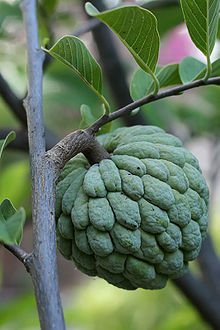
Back ግሽጣ Amharic قشدة صدفية Arabic قشطه صدفيه ARZ Annona squamosa AST Silik BAN Захарна ябълка Bulgarian Sunsun BM Annona squamosa Catalan Annona squamosa CEB Åtes CH
| Annona squamosa | |
|---|---|

| |

| |
| Cross section of the fruit shown on right | |
| Scientific classification | |
| Kingdom: | Plantae |
| Clade: | Tracheophytes |
| Clade: | Angiosperms |
| Clade: | Magnoliids |
| Order: | Magnoliales |
| Family: | Annonaceae |
| Genus: | Annona |
| Species: | A. squamosa
|
| Binomial name | |
| Annona squamosa | |
| Synonyms | |
|
Annona asiatica L.[3] | |
Annona squamosa is a small, well-branched tree or shrub[7] from the family Annonaceae that bears edible fruits called sugar apples or sweetsops.[8] It tolerates a tropical lowland climate better than its relatives Annona reticulata and Annona cherimola[6] (whose fruits often share the same name)[3] helping make it the most widely cultivated of these species.[9] Annona squamosa is a small, semi-(or late) deciduous,[10] much-branched shrub or small tree 3 to 8 metres (10 to 26 feet) tall[7][10] similar to soursop (Annona muricata).[11] It is a native of tropical climate in the Americas and West Indies, and Spanish traders aboard the Manila galleons docking in the Philippines brought it to Asia.[12]

The fruit is spherical-conical, 5–10 centimetres (2–4 inches) in diameter and 6–10 cm (2+1⁄4–4 in) long, and weighing 100–240 grams (3.5–8.5 ounces), with a thick rind composed of knobby segments. The colour is typically pale green through blue-green, with a deep pink blush in certain varieties, and typically has a bloom. It is unique among Annona fruits in being segmented; the segments tend to separate when ripe, exposing the innards.
The flesh is fragrant and sweet, creamy white through light yellow, and resembles and tastes like custard. The seeds are coated with the flesh, It is found adhering to 13-to-16-millimetre-long (1⁄2 to 5⁄8 in) seeds forming individual segments arranged in a single layer around a conical core. It is soft, slightly grainy, and slippery. The hard, shiny seeds may number 20–40 or more per fruit and have a brown to black coat, although varieties exist that are almost seedless.[12][13] The seeds can be ground for use as an insecticide.[8]The stems run through the centre of the fruit connecting it to the outside. The skin is shaped like a Reuleaux triangle coloured green and rough in texture. Due to the soft flesh and structure of the sugar apple it is very fragile to pressure when ripe.
New varieties are also being developed in Taiwan and Hong Kong. The atemoya or "pineapple sugar-apple", a hybrid between the sugar-apple and the cherimoya, is popular in Taiwan, although it was first developed in the United States in 1908. The fruit is similar in sweetness to the sugar-apple, but has a very different taste. As its name suggests, it tastes like pineapple.
- ^ Botanic Gardens Conservation International (BGCI); IUCN SSC Global Tree Specialist Group (2019). "Annona squamosa". IUCN Red List of Threatened Species. 2019: e.T146787183A146787185. doi:10.2305/IUCN.UK.2019-2.RLTS.T146787183A146787185.en. Retrieved 16 December 2022.
- ^ Natural Resources Conservation Service (NRCS). "PLANTS Profile, Annona squamosa L". The PLANTS Database. United States Department of Agriculture. Retrieved 2008-04-17.
- ^ a b "Annona squamosa". Germplasm Resources Information Network. Agricultural Research Service, United States Department of Agriculture. Retrieved 2008-04-17.
- ^ Dr. Richard Wunderlin, Dr. Bruce Hansen. "synonyms of Annona squamosa". Atlas of Florida Vascular Plants. Institute for Systematic Botany, University of Florida. Retrieved 2008-04-17.
- ^ Missouri Botanical Garden (1753). "Annona squamosa L". Tropicos. Retrieved 2008-04-17.
- ^ a b "Current name: Annona squamosa". AgroForestryTree Database. International Center For Research In Agroforestry. Archived from the original on 2011-05-26. Retrieved 2008-04-17.
- ^ a b "Compilation: Annona squamosa". Global Plants. JSTOR. Retrieved 2019-09-05.
- ^ a b The Complete Guide to Edible Wild Plants. United States Department of the Army. New York: Skyhorse Publishing. 2009. p. 100. ISBN 978-1-60239-692-0. OCLC 277203364.
{{cite book}}: CS1 maint: others (link) - ^ Morton, Julia (1987). "Sugar Apple Annona squamosa". Fruits of warm climates. Department of Horticulture & Landscape Architecture, Purdue University. p. 69. Archived from the original on 5 April 2008. Retrieved 2008-04-17.
- ^ a b Kral, Robert. "Annona squamosa Linnaeus, Sp. Pl. 1: 537. 1753". In Flora of North America Editorial Committee (ed.). Flora of North America North of Mexico. Vol. 3. Retrieved 2019-09-05.
- ^ "Annona squamosa". Pacific Island Ecosystems at Risk (PIER). 2008-01-05. Archived from the original on 12 May 2008. Retrieved 2008-04-17.
- ^ a b Morton, Julia (1987). "Annona squamosa". Fruits of warm climates. p. 69. Retrieved 6 March 2013.
- ^ "Annona squamosa". AgroForestryTree Database. Archived from the original on 14 March 2007. Retrieved 16 September 2013.
